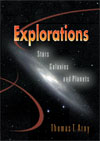 |
1 |  | 
Which terrestrial planets have the greatest radius? (That is, which is largest?) |
|  | A) | Mercury |
|  | B) | Venus |
|  | C) | Earth |
|  | D) | Mars |
 |
 |
2 |  | 
List the terrestrial planets in order of increasing density. |
|  | A) | Mercury, Venus, Earth, Mars |
|  | B) | Mercury, Mars, Venus, Earth |
|  | C) | Mars, Mercury, Venus, Earth |
|  | D) | Earth, Mercury, Venus, Mars |
 |
 |
3 |  | 
Does Mercury have an atmosphere? Why or why not? |
|  | A) | Yes. Mercury's has a substantial atmosphere of solar hydrogen and helium. |
|  | B) | Yes, but it is only one-tenth the atmosphere of Venus. |
|  | C) | No, only traces of gases temporarily captured from space. Mercury's gravitational force is too weak to retain an atmosphere in its hot environment. |
|  | D) | Astronomers have not been able to tell so far. |
 |
 |
4 |  | 
What is the surface of Mercury like? |
|  | A) | Rocky, with craters and scarps. |
|  | B) | Rocky, with volcanoes and old ocean basins. |
|  | C) | Gaseous. |
|  | D) | Mostly rock, but covered about 40% by liquid methane. |
 |
 |
5 |  | 
What does Mercury most resemble in size and appearance? |
|  | A) | Venus |
|  | B) | Mars |
|  | C) | the Moon |
|  | D) | Earth |
 |
 |
6 |  | 
Mercury's average density is about 50% greater than the Moon's, even though the two bodies have similar radii. This suggests that Mercury('s) |
|  | A) | interior is much richer in iron than the Moon's. |
|  | B) | contains proportionately far more rock than the Moon. |
|  | C) | greater mass has prevented its gravitational attraction from compressing it as much as the Moon is. |
|  | D) | must have a liquid water core. |
 |
 |
7 |  | 
Despite its thick cloud cover, astronomers can observe the surface of Venus with |
|  | A) | visible light. |
|  | B) | ultraviolet light. |
|  | C) | infrared light. |
|  | D) | radar. |
 |
 |
8 |  | 
What is the dominant gas in Venus's atmosphere? |
|  | A) | Carbon dioxide. |
|  | B) | Water vapor. |
|  | C) | Methane. |
|  | D) | Nitrogen. |
 |
 |
9 |  | 
What are the clouds of Venus mainly composed of? |
|  | A) | Methane. |
|  | B) | Water vapor. |
|  | C) | Sulfuric acid droplets. |
|  | D) | Carbon dioxide. |
 |
 |
10 |  | 
Why is Venus's surface hotter than Mercury's? |
|  | A) | Venus rotates more slowly, so it "bakes" more in the Sun's heat. |
|  | B) | Clouds in Mercury's atmosphere reflect sunlight back into space and keep its surface cool. |
|  | C) | Carbon dioxide in Venus's atmosphere traps heat radiating from its surface, thereby making it warmer. |
|  | D) | Venus is closer to the Sun. |
 |
 |
11 |  | 
Which group contains only features that can be seen on the surface of Mars? |
|  | A) | canyons, oceans, volcanoes, polar caps |
|  | B) | craters, canyons, polar caps, volcanoes |
|  | C) | polar caps, oceans, dried up river beds |
|  | D) | all of the above |
 |
 |
12 |  | 
The Martian polar caps are composed of frozen |
|  | A) | water and carbon dioxide. |
|  | B) | water and methane. |
|  | C) | methane and carbon dioxide. |
|  | D) | water and sulfuric acid. |
 |
 |
13 |  | 
Of these, which is evidence that Mars once had running water on its surface? |
|  | A) | There are vast amounts of H2O present in Martian rocks. |
|  | B) | There is medium sized ocean in the southern hemisphere of Mars. |
|  | C) | Spacecraft have observed channels and dry riverbeds on the Martian surface. |
|  | D) | There is no such evidence. |
 |
 |
14 |  | 
Why do astronomers think the Earth ended up with so little CO2 compared with Mars and Venus? |
|  | A) | Plant life and abundant water have removed most of the CO2, locking it into rocks and the oceans. |
|  | B) | Volcanoes on Earth outgassed less CO2 than on Venus and Mars. |
|  | C) | Comets striking the surfaces of Venus and Mars added CO2 to their atmospheres, but not to Earth. |
|  | D) | Pollution on Earth has reduced the amount of CO2 originally present. |
 |
 |
15 |  | 
Some recent evidence points to the possibility of there being some liquid water on Mars “recently.” Why does this puzzle astronomers? |
|  | A) | Currently Mars is too hot for liquid water. |
|  | B) | The Martian atmosphere is too thick and clouds would form. |
|  | C) | The Martian atmosphere is too cold and has too low a pressure for liquid water. |
|  | D) | all of the above |
 |



 2002 McGraw-Hill Higher Education
2002 McGraw-Hill Higher Education